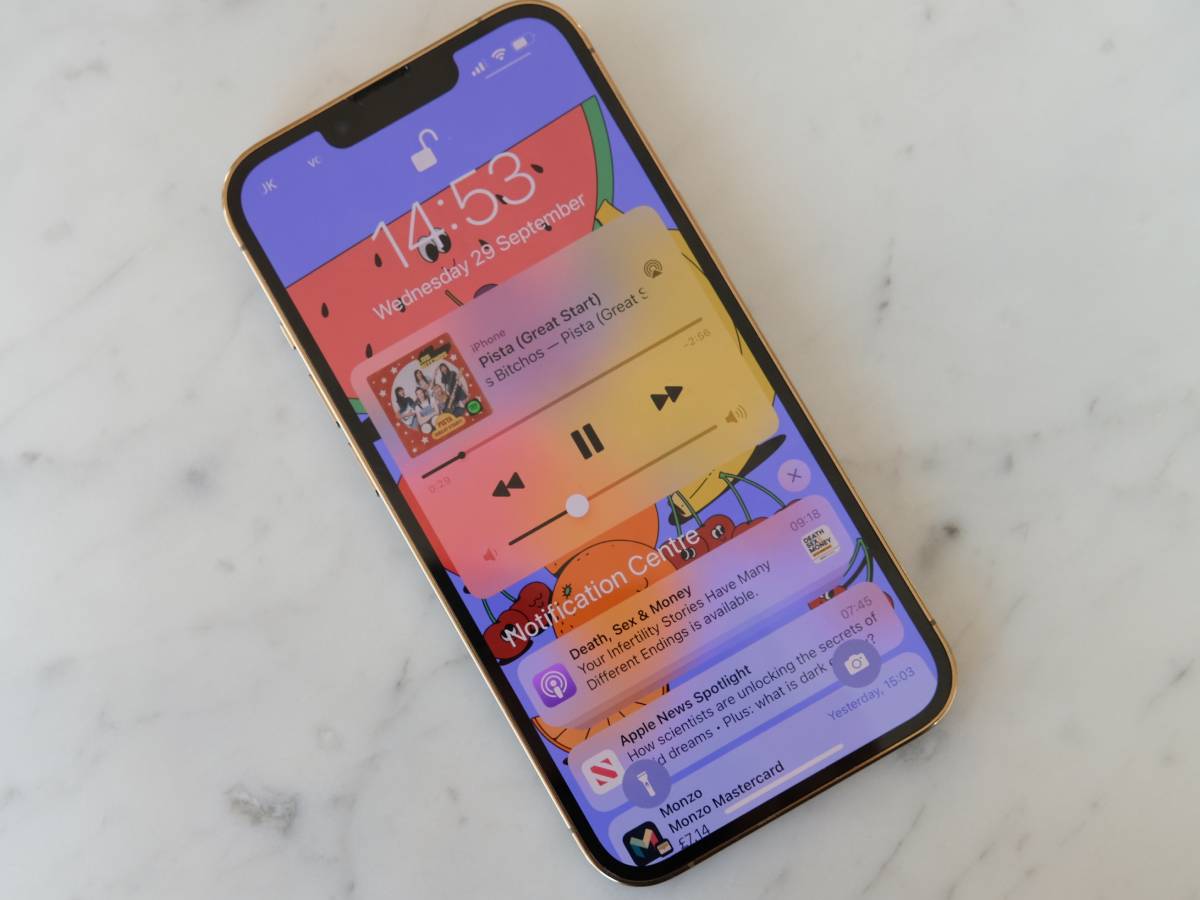Apple iPhone 13 Pro review
Nothing says the gap is narrowing between the Pro and Pro Max like this shiniest new iPhone addition

Stuff Verdict
The iPhone 13 Pro is camera extraordinaire and although is late to the party with many features, it does them so well, like Macro photography and adaptive refresh rates. It’s the best Apple has to off
Pros
- Superb camera
- All day battery
Cons
- Weighty
Roll back to 2020. If you opted for an iPhone 12 Pro, you had to deal with the crushing reality that although you’d shelled out the best part of a grand to get one of the best smartphones around, you still didn’t have the best camera Apple was capable of making.
On paper, the 12 Pro Max edged it on camera specs and had the added bonus of a beefier battery too. But for the next generation, Apple furnished both the 13 Pro and 13 Pro Max with its most ambitious camera unit yet – and now offers macro photography.
A handful of other upgrades include a longer-lasting battery and ProMotion, for an adaptive refresh rate that can go up to 120Hz or as low as 10Hz. It’s great for battery conservation.
Want the zenith of all camera phones without having to lumber around a hulking cuboid like the iPhone Pro Max? And you want more than the standard iPhone 13? Then this might be the sweet spot.
Review first published 5 October 2021
How we test smartphones
Every phone reviewed on Stuff is used as our main device throughout the testing process. We use industry standard benchmarks and tests, as well as our own years of experience, to judge general performance, battery life, display, sound and camera image quality. Manufacturers have no visibility on reviews before they appear online, and we never accept payment to feature products. Find out more about how we test and rate products.
Design and build: The thick of it



2020 saw Apple embracing edges with both its smartphones and the latest iPads, waving goodbye to the smooth curves of yonder iPhones.
The iPhone 13 Pro looks remarkably like its predecessor. The stainless steel edges are a touch of bling, the smooth matt finish on the rear with a subtle Apple logo works well as a contrast. Ceramic glass sandwiches the front and back for extra toughness, though I still popped it straight in a case.
The camera bulge is bulgier than ever, and wider too, taking up more space on the rear. The phone doesn’t sit flat on a surface as a result. That makes it even more important to make sure you protect those camera lenses.
Weight has climbed from 189g to 204g with this latest iPhone iteration. You can feel the extra weight and while I don’t love it, if it means that it’ll last longer — the weight gain is to accommodate the larger battery – I can live with it.
Everyone’s on notch watch these days; alas, it’s still present here, as it’s necessary for a lot of the tech we love from the iPhone. However it is narrower, by almost a centimeter.
The Lightning port remains (for this generation, at least) and the ususal iPhone colours of gold, silver and graphite all make an appearance. Apple also introduced a lovely new Sierra Blue, which is reminiscent of a clear morning sky.
Screen and sound: Have I got views for you

The 6.1in Super Retina XDR OLED display is the very same as last year, but that’s no shame because it’s all kinds of excellent. It’s allegedly brighter too, bumping up to 1000 nits of outdoor brightness. I had no issue viewing the screen outside and from all angles. Colours remain vibrant, with excellent contrast. It’s great for watching films and gaming.
For new tricks, look at the ProMotion dynamic refresh rate. It goes all the way to 120Hz and makes for a more fluid screen experience. When flicking between apps it feels extra smooth and super responsive. The tech also has the ability to ratchet down the refresh rates when the task doesn’t call for such speeds, like reading or typing notes. Sadly, the iPhone 13 and 13 Mini are stuck at 60Hz and don’t benefit from the tech.
Built-in stereo speakers do a phenomenal job of offering fully rounded audio. They’re great for playing podcasts before bed and handy if you forget your portable speakers. Apple’s spatial audio is on board, though playing through your phone isn’t the best way to experience it.
Voice isolating mics also mean calls and voice notes are delivered with clarity. Wide spectrum does the opposite, allowing in more background sounds for when you’re in a video call with multiple people on your end of the line.
Performance and battery: Saved by the cell



Apple tends not to reveal its battery capacities, but teardowns would strongly suggest that inside the iPhone 13 Pro sits a 3,095mAh battery. That’s substantially larger than its predecessor but still nowhere near its 2-day trooper of a big brother, the iPhone 13 Pro Max.
In reality, if you’re a heavy user then the iPhone 12 Pro wouldn’t last you ‘til bedtime, but the iPhone 13 Pro certainly will. Intense video use really drains the phone with things like Cinematic Mode making a real dent into battery life.
On a working day from home which involved syncing with a smartwatch, playing some tunes via Spotify, checking emails, WhatsApping and some news scrolling, the battery was still at a healthy 70% which is a huge upgrade from the iPhone 11 Pro.
The A15 Bionic chip is world-beating, offering incredible processing skills that touch a multitude of the iPhones components, from gaming to photography. A few hours playing Genshin’s Impact proves the new chip to be capable of serious heavy lifting, delivering smooth graphics with the added ProMotion muscle.
Cinematic Mode for video and all the photography wizardry are all powered by A15 Bionic and it’s the gateway to the iPhone’s capabilities. Take Lightroom, for example: the iPhone 13 Pro dealt with huge files with aplomb and photo editing was speedy and effective. It’s no shock that 5G comes as standard which you can now expect from all iPhones from here on.
Camera: Big Bang Peery



Battery aside, it’s the cameras that are the standout feature this year – and not just because of software tweakery. Apple has made some hardware changes, namely making the lead camera’s lens aperture wider. The camera set-up is also identical to the iPhone 13 Pro Max, which means you can have the best camera on a phone which you can use one-handed.
The rear snapper setup breaks up into three 12MP cameras: the main lens, an ultra-wide, and a telephoto. Sounds just like the last iPhone? Well not quite. The aperture on the ultra-wide camera jumps from f/2.4 to f/1.8, allowing in more light and making huge improvements to night time photography. The upgraded telephoto camera comes with 3X optical zoom, which is a step up from last year and finally, the main sensor has an f/1.5 aperture.
Nighttime photography is the best I’ve seen. Rather than increasing brightness to unrealistic levels, low light shots are handled with much more subtlety and style.
In daylight, the camera is phenomenal, but then so is any other recent high-end iPhone. To further up the ante though, the iPhone 13 Pro is capable of Macro photography. I’ve seen this from Android competitors previously, but it’s seriously good here and quite addictive.
Computational photography has been finessed to a fault and image quality is superb. There’s a new feature called ‘Profiles’ in the camera app, which allows you to apply a filter before pressing the shutter, rather than applying one later. Each option (including vibrant, cool, warm, and rich contrast) has a slider, so you can ramp it up or slide it down for a more subtle take.
Video is far from neglected. A headline feature this year is Cinematic Mode, which lets you shoot a scene and then change the focus point, either while shooting or in post-production. It’s incredibly fun to play around with and works with the front facing camera too. There is one caveat though: Cinematic mode will only work in 1080p at 30fps, which will disappoint a few Tarantino wannabes.
More useful is the sensor-based stabilisation, which proves real gains for iPhone videography. It’s even effective in low light. Cinematic Mode in low light raises the same issues as portrait mode, with the occasional blurry edges especially around hair.
Fancy tricks aside, the iPhone 13 Pro camera is quite possibly the best in the business when it comes to smartphone photography.
Apple iPhone 13 Pro verdict



The iPhone 13 Pro is Apple’s most accomplished phone yet, with the Bionic 15 chip, 5G, a battery to last at least a full day and the best camera system on any smartphone. It’s my pick from the iPhone 13 lineup. Since they all have a bigger battery, and the 13 Pro gets identical cameras, it’s harder to make a compelling argument from the iPhone 13 Pro Max, unless you’re a content creator glued to your iPhone.
The cheaper iPhone 13 still offers an improved battery, the latest Bionic chip, 5G and an incredibly impressive camera powers. What it lacks is that third telephoto lens and the adaptive refresh rate, so it really boils down to your smartphone priorities.
All the advancements you see here are incremental, but when you add them all up, it’s not insignificant. Some of the features seem a bit overkill, but a larger battery and boosted camera is exactly the kind of meaningful upgrade users so desperately wanted and now, with the iPhone 13 Pro, get.
Stuff Says…
The iPhone 13 Pro is camera extraordinaire and although is late to the party with many features, it does them so well, like Macro photography and adaptive refresh rates. It’s the best Apple has to offer in way of 2021 smartphones.
Pros
Superb camera
All day battery
Cons
Weighty
Apple iPhone 13 Pro tech specs
| Display | 6.1in 2532×1170 OLED HDR (up to 120Hz refresh rate) |
| Processor | A15 |
| RAM | 6GB |
| Storage | 512GB |
| OS | iOS 15 |
| Cameras | 12MP (wide), 12MP (ultrawide), 12MP (telephoto) & ToF 3D LiDAR rear, 12MP front camera |
| Battery | 3,095mAh (est) |


